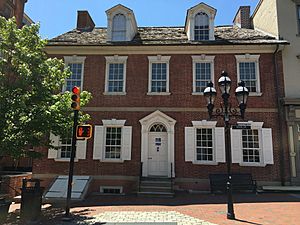Goundie House facts for kids
Quick facts for kids 1810 Goundie House |
|
|---|---|
 |
|
| Location | Bethlehem, Pennsylvania |
| Built | 1810 |
| Built for | Private Residence |
| Original use | Town Brewer’s Residence |
| Restored | 1980s |
| Restored by | Historic Bethlehem Inc. |
| Current use | Historic Tours, Exhibitions, Programming, Pop-Up Vintage Market |
| Architectural style(s) | American Federal |
| Governing body | Local |
| Website | HistoricBethlehem.org |
| Lua error in Module:Location_map at line 420: attempt to index field 'wikibase' (a nil value). | |
The Goundie House is a historic building in Bethlehem, Pennsylvania. It was built in 1810 for John Sebastian Goundie, who was a brewer for the Moravian community. This house is special because it's thought to be the first brick home in Bethlehem. It was also the first private house to show the American Federal style of architecture. Today, the Goundie House is a museum. It hosts exhibitions, special events, and even pop-up vintage shops. It's part of the Historic Moravian Bethlehem District, which is a very important historical area.
Contents
The Story of the Goundie House
John Goundie's Journey to Bethlehem
John Sebastian Goundie was a skilled brewer from Germany. He first arrived in Bethlehem, Pennsylvania, in 1802. He had been invited to be a brewer in Salem, North Carolina. However, he didn't stay long in Salem. Some say he didn't like the brewery location there.
After a few months, Goundie returned to Bethlehem in 1803. He spoke with Bishop George Henry Loskiel, a leader in the Moravian community. It was decided that Goundie would become the new brew master in Bethlehem.
Building a Unique Home
Goundie was a very ambitious and forward-thinking businessman. He often had ideas that were different from the local leaders, called the Aufseher Collegium. In 1804, he married Cornelia Andreas. By 1808, he had saved enough money to want to buy a house. He wanted to buy property owned by the Collegium.
The Collegium used a special "lot system" to decide things. This meant they would draw a result from a box, believing it was God's will. However, by the early 1800s, many people in the community didn't trust this method as much. In October 1808, Goundie was denied the houses he wanted. He was very frustrated and even threatened to leave Bethlehem.
But by 1810, Goundie had built the house he wanted. It's not clear exactly how this happened, as there are no records explaining it. However, old pictures show the house and a lease for the land from the church.
A New Style of Architecture
The Goundie House was very different from other buildings in Bethlehem. Most homes were made of stone in the German Colonial style. But Goundie's house was the first brick home built in the American Federal style. This was a big change!
The house is two and a half stories tall. It measures about 40 feet by 33 feet. Inside, it has a main hallway with two rooms on each side on both the first and second floors. A special feature is a beehive oven that connects fireplaces on both floors. Goundie lived here with his wife and their six children.
Brewing and Community Life
In 1811, Goundie became worried about his brewing. The water he used from the Monocacy Creek was getting dirty from a nearby tannery. He decided a new brewery was needed. He suggested a spot near his house.
After some discussion, the Collegium agreed to Goundie's plan. A new brewery was built in 1812. Goundie also built a water tank on his property. He even tore down an old building and built a malt house for making brandy. The community was very happy with his beer. They even said it was better than the more expensive beer from Philadelphia!
Goundie continued to improve his brewing over the years. He also became involved in the town's public life. In 1820, he became a fire-inspector. In 1822, he was asked to be Mayor, but he turned it down. By the late 1820s, he was on the Overseers Board and a committee for building lots.
When the Lehigh Canal was built in 1827, it brought many changes to Bethlehem. Even with these big changes, Goundie continued to do well. By the 1830s, he stopped being a brew master. He then worked with the important Rice family on private businesses.
Changes Over the Years
In 1832, Goundie built a dry-goods store right next to his house. His daughter and son-in-law managed this store. In 1852, Goundie sold his home to Louis Beckel for $5,070. Goundie passed away shortly after.
Beckel made some changes to the house. In the 1880s, he added a third floor and more decorations. After Goundie's death, the house had many different owners and uses. It was a doctor's office, a boarding house, a shoe repair shop, and even a travel agency.
Saving the Goundie House
In 1968, the Goundie House was almost torn down. But two women, Christine Sims and Frances Martin, stepped in to save it. They worked hard to stop the demolition. Later that year, Historic Bethlehem Inc. bought the building for $22,000 using money they raised.
Throughout the 1980s, the house was carefully restored to look like it did when Goundie lived there. Mrs. Sims, Mrs. Martin, and many supporters of Historic Bethlehem helped with this huge project.
During the restoration, they found the original doorway that connected Goundie's house to the shop next door. They also found an old pressed tin ceiling from the 1870s. Today, the 1810 Goundie House is a museum. It offers tours, exhibitions, and pop-up shops. It is owned by Historic Bethlehem Inc., a non-profit organization that helps preserve history.

